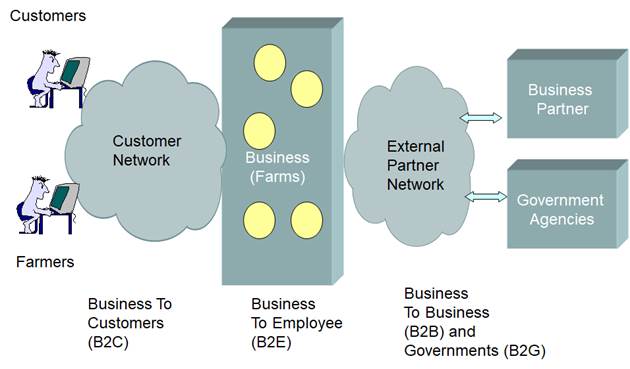
Simply stated, e-commerce, also known as eCommerce, is buying and selling over the Internet. E-commerce transactions may involve material goods, knowledge services (e.g., online courses), or rights and obligations. Payment may be online or off the Internet. Access to Internet communication channels used in e-commerce is often open to everyone but is sometimes restricted, and the messages exchanged may be rigidly standardized.
Farmers around the globe are increasingly using e-commerce to procure essential items needed for farming and directly reaching the diverse customer populations over the Internet. The global Internet allows them to move away from physical local stores and regional farming cooperatives. Although Internet adoption has historically been slow among farmers for making agricultural purchases, current increases in broadband internet availability and economic and market pressures have pushed the farmers online for better deals.
E-commerce transactions are often classified according to the partners involved – consumers, employees, businesses, and governments, as shown in Figure1. Many combinations are possible but the most common, captured in Figure1, are:

Figure1: eCommerce for Agriculture – Conceptual View
The e-commerce platform supports these and many other interactions and also:
(1) saves transaction costs
(2) integrates many e-commerce services
(3) provides many resources for e-market
(4) provides support services
Figure 2 shows a more detailed architecture of the e-commerce4agriculture portal that illustrates the key players (customers, administrates and farmers) and the key ecommerce capabilities needed (e.g., Internet access, Internet-based marketing and selling of farm commodities and products, ecommerce support for agriculture raw materials, and additional services such as tourism and training). These capabilities are explained in more detail below.

Figure2: eCommerce for Agriculture – A Detailed View
· Internet Access, Search, & Collaboration Services to attract more customers and collaborate with potential partners
· Focus on Internet-based Marketing, Selling, Customer Support, Branding & Product Strategy for Business Development. Each farm acts as a company with a business plan that is revised annually. The focus is on the market needs and pricing changes and consultation with particular consulting companies for more specific information. In addition, brand is very important. Some farms may try to advertise or provide special commodities to improve their reputation and attract more customers. They may also cooperate and collaborate with other agriculture companies to strengthen their position.
· Online Sales of Agricultural Commodities and Products. This is the traditional B2C part of agriculture and includes crop and live stock, forestry, fruits, grains, and seeds. Farms also provide agroforestry, aquaculture, biomass, fiber, forestry, fruits, grains, oilseeds, nuts, vegetables, and specialty crops.
· Administration of Agriculture Raw Materials and Tools (e.g., Pesticide, Seeds, & Farming Tools). Specifically, farming needs the following:
a) Seeds such as seeds for planting, babies for livestock, trees for forestry and fish for aquatic.
b) Energy for farms, including water and electricity, and possibly renewable energy like solar energy and wind energy.
c) Pesticide and herbicide, including antimicrobial pesticides, biopesticides, specialized fertilizers, toxics etc.
d) Farming tools such as tractors and plows. Modern farms utilize information and communication technology to manage their infrastructure, and GPS plus satellite services for higher harvesting.
· Additional Services (e.g., Tourism, Recruitment, Food Safety, Consulting & Training). This includes rural tourism for people who may schedule a rural trip online. Also, e-commerce provides an employment platform for people with specialized skills.